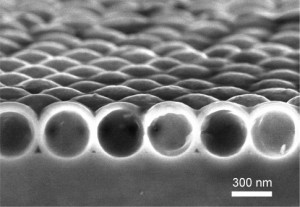Whispering galleries are always popular with all ages. I know that because I can never get enough time in them as I jostle with seniors, children, young adults, etc. For most humans, the magic of having someone across from you on the other side of the room sound as if they’re beside you whispering in your ear is ever fresh.
It’s the roundness of the space, which gives it that special acoustic quality. Taking their inspiration from whispering galleries, engineers at Stanford University have created hollow nanoshell ‘whispering galleries’ for light rather than sound. From the Feb. 7, 2012 news item on Nanowerk,
The engineers call their spheres nanoshells. Producing the shells takes a bit of engineering magic. The researchers first create tiny balls of silica — the same stuff glass is made of — and coat them with a layer of silicon. They then etch away the glass center using hydrofluoric acid that does not affect the silicon, leaving behind the all-important light-sensitive shell. These shells form optical whispering galleries that capture and recirculate the light.
“The light gets trapped inside the nanoshells,” said Yi Cui, associate professor of materials science engineering at Stanford and a senior author of the paper. “It circulates round and round rather than passing through and this is very desirable for solar applications.”
The researchers estimate that light circulates around the circumference of the shells a few times during which energy from the light gets absorbed gradually by the silicon. The longer they can keep the light in the material, the better the absorption will be.
“This is a new approach to broadband light absorption. The use of whispering-gallery resonant modes inside nanoshells is very exciting,” said Yan Yao, a post-doctoral researcher in the Cui Lab and a co-lead author of the paper. “It not only can lead to better solar cells, but it can be applied in other areas where efficient light absorption is important, such as solar fuels and photodetectors.”
The nanoshells look like this,

A scanning electron microscope (SEM) image of a single layer of nanocrystalline-silicon shells. The hollow shell structure improves light absorption while reducing the cost and weight of the device. Image: Yan Yao
Andrew Meyers’ Feb. 2012 article for Stanford University’s School of Engineering notes that improved light absorption isn’t the only advantage to this ‘whispering-gallery resonant mode’ technique,
Having demonstrated improved absorption, the engineers went on to show how their clever structure will pay dividends beyond the mere trapping of light.
First, nanoshells can be made quickly. “A micron-thick flat film of solid nanocrystalline-silicon can take a few hours to deposit, while nanoshells achieving similar light absorption take just minutes,” said Yan.
The nanoshell structure likewise uses substantially less material, one-twentieth that of solid nanocrystalline-silicon.
“A twentieth of the material, of course, costs one-twentieth and weighs one-twentieth what a solid layer does,” said Jie. “This might allow us to cost effectively produce better-performing solar cells of rare or expensive materials.”
“The solar film in our paper is made of relatively abundant silicon, but down the road, the reduction in materials afforded by nanoshells could prove important to scaling up the manufacturing of many types of thin film cells, such as those which use rarer materials like tellurium and indium” said Vijay Narasimhan, a doctoral candidate in the Cui Lab and co-author of the paper.
Finally, the nanoshells are relatively indifferent to the angle of incoming light and the layers are thin enough that they can bend and twist without damage. These factors might open up an array of new applications in situations where achieving optimal incoming angle of the sun is not always possible. Imagine solar sails on the high seas or photovoltaic clothing for mountain climbing.
The researchers’ paper was published in Nature Communications and the authors include: Shanhui Fan, a professor of electrical engineering, Yi Cui, associate professor of materials science engineering, Yan Yao, a post-doctoral researcher in the Cui Lab, Vijay Narasimhan, a doctoral candidate in the Cui Lab, and Jie Yao, a post-doctoral researcher in the Cui Lab.